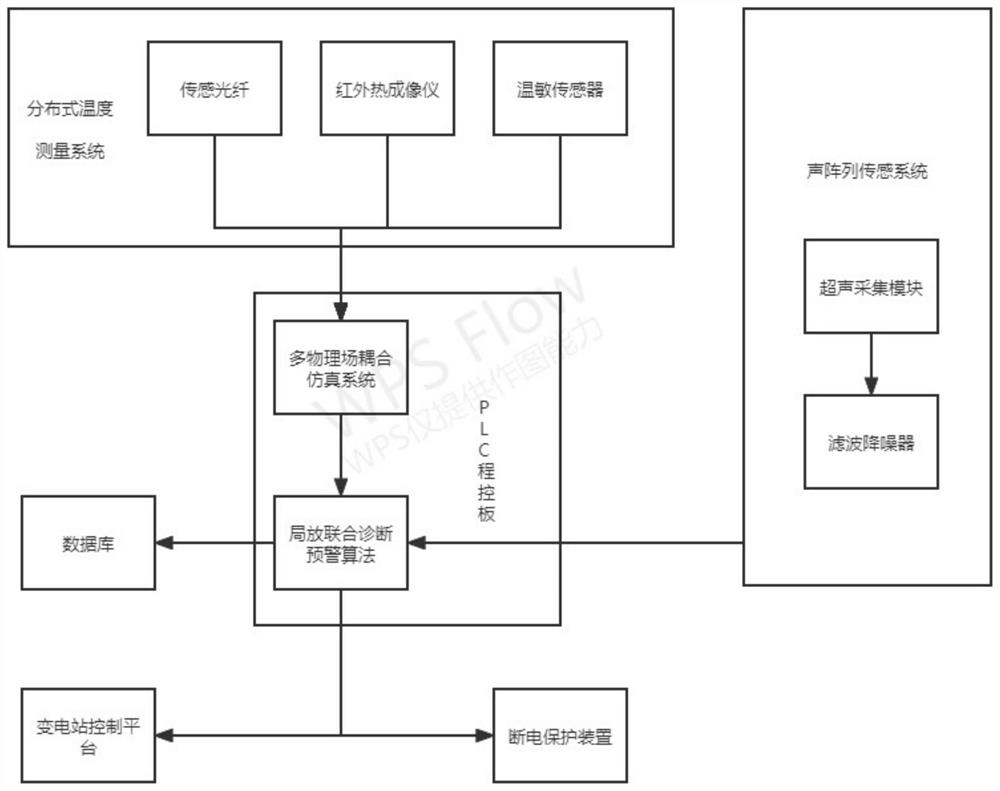Dry-type reactor fault early warning system based on distributed detection
A dry-type reactor, fault warning technology, applied in the direction of measuring electricity, fault location, measuring electrical variables, etc., can solve the problem that the infrared temperature sensor cannot be installed, cannot reflect the temperature rise distribution of the reactor, and the airway gap in the envelope small problems
- Summary
- Abstract
- Description
- Claims
- Application Information
AI Technical Summary
Problems solved by technology
Method used
Image
Examples
Embodiment 1
[0049] As shown in the figure, this embodiment provides a dry reactor fault early warning system based on distributed detection, including a reactor, the reactor includes an iron core and a wire turn, and a distributed temperature set on the reactor A measurement system, a multi-physics coupling simulation system connected with the distributed temperature measurement system, a partial discharge joint diagnosis and early warning algorithm connected with the multi-physics coupling simulation system, the partial discharge joint diagnosis and early warning algorithm and the acoustic The array sensing system is connected, the partial discharge joint diagnosis and early warning algorithm is connected with the database, the distributed temperature measurement system and the multi-physics coupling simulation system are connected by an anti-interference metal shielding line, and the multi-physics The field coupling simulation system and the partial discharge joint diagnosis and early wa...
Embodiment 2
[0071] This embodiment is a supplementary description on the basis of Embodiment 1, and the location of the sensing fiber:
[0072] The pulsed light emitted by the pulsed light source enters the fiber from the starting end of the fiber. After time t / 2, it reaches the scattering point. At the scattering point, the photons interact with the fiber molecules to generate scattering. The distance from the starting point to the scattering point is set to L. The backscattered light returns to the starting end of the fiber in the opposite direction to the incident light, the distance traveled is L, the time is t / 2, and the relationship between t and L is:
[0073]
[0074] In the formula, c is the propagation speed of light in vacuum, and n is the refractive index of the fiber core.
[0075] Therefore, when the parameters c and n are known, the distance L from the scattering point to the beginning of the fiber can be obtained by measuring the time t required from the injection of th...
Embodiment 3
[0077] This embodiment is a supplementary description on the basis of Embodiment 1. The mathematical model of the fluid temperature field:
[0078] Since the dry reactor model is a three-dimensional axisymmetric structure, a cylindrical coordinate system can be used for modeling and two-dimensional simulation to simplify the analysis.
[0079] In the cylindrical coordinate system, the governing equation of the magnetic field is
[0080] In the cylindrical coordinate system, the governing equation of the magnetic field is
[0081]
[0082] In the formula: r is the radial distance in the cylindrical coordinate system; z is the axial distance; A is the magnetic vector potential; μ0 is the magnetic permeability; J is the source current density.
[0083] The constraint equation of the i-th layer coil by the external circuit is:
[0084]
[0085]
[0086]
[0087] In the formula, U is the external restraint voltage, and Ri, i, Ni, Ii, and Si are the resistance, flux li...
PUM
 Login to View More
Login to View More Abstract
Description
Claims
Application Information
 Login to View More
Login to View More - R&D
- Intellectual Property
- Life Sciences
- Materials
- Tech Scout
- Unparalleled Data Quality
- Higher Quality Content
- 60% Fewer Hallucinations
Browse by: Latest US Patents, China's latest patents, Technical Efficacy Thesaurus, Application Domain, Technology Topic, Popular Technical Reports.
© 2025 PatSnap. All rights reserved.Legal|Privacy policy|Modern Slavery Act Transparency Statement|Sitemap|About US| Contact US: help@patsnap.com



